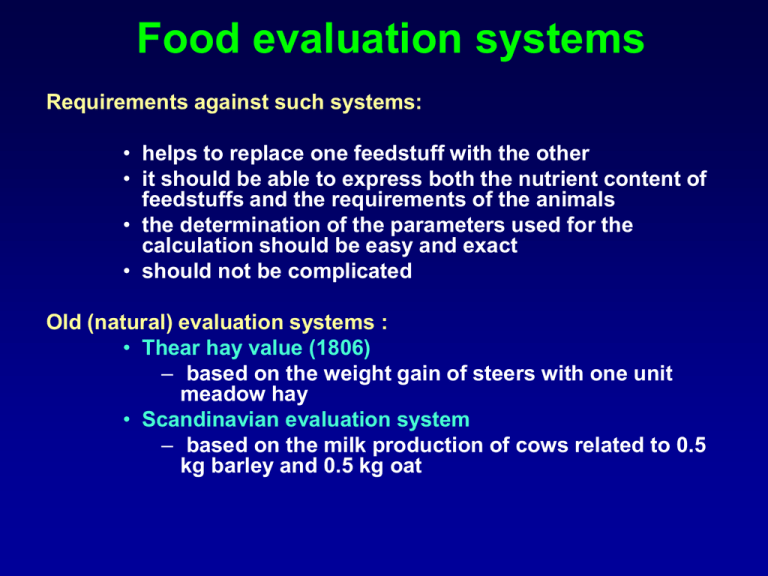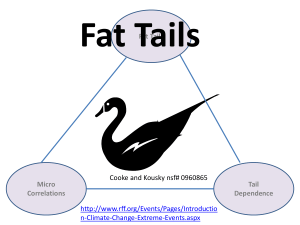
Food evaluation systems
Requirements against such systems:
• helps to replace one feedstuff with the other
• it should be able to express both the nutrient content of
feedstuffs and the requirements of the animals
• the determination of the parameters used for the
calculation should be easy and exact
• should not be complicated
Old (natural) evaluation systems :
• Thear hay value (1806)
– based on the weight gain of steers with one unit
meadow hay
• Scandinavian evaluation system
– based on the milk production of cows related to 0.5
kg barley and 0.5 kg oat
Evaluation systems based on the digestible nutrient
content:
TDN (total digestible nutrients)
TDN = dig. crude prot. + dig.crude fibre + dig.N-free extr. + 2,25 x
dig. crude fat
The calculation of TDN is based on the energy content of the
different nutrients:
crude fibre, N-free extract: 17,5 KJ/g
crude protein: 24,0 KJ/g
crude fat: 39,5 KJ/g
Gross energy:
The heat increment after the total burning of the pure nutrient in
oxygen. The so called bomb calorimeters are used for the
determination.
TDN was used worldwide in the ruminant nutrition. In the energy
evaluation system of ruminants is still used.
Calculation of TDN (grass silage)
nutrient
g/kg d.m. digestibility
coefficient
factor
crude protein
127,5
0,60
= 76,5
crude fat
50,1
0,60
crude fibre
319,3
0,65
= 207,5
N-free extract
396,1
0,55
= 217,8
2,25
= 67,6
TDN = 569,4
g/kg
d.m.
The need for dietary energy:
• to produce heat to maintain the body temperature at a higher level than the
environment
• for the synthesis of large molecules from smaller ones (for the normal
replacement of muscle fibres, hormones, enzymes and for tissue growth) and
sometimes for their transport in the body
• for the contraction of muscle fibres, for breathing, the beating of the heart and
for all movement.
The efficiency of the use of food energy for the different purposes is change
widely, from about less than 10% (foetal growth) till 60% (growth). The other
90% - 40% appearing as heat.
Units of energy
Dietary energy is measured in kilocalories (kcal) or in kilojoules or megajoules
where:
1 kilojoule (kJ) =1000 joules (J)
1 megajoule (MJ) = 1000 kJ
1 kcal = 4.184 kJ
Although the joule is the SI unit and so should be the unit of choice, the calorie is
also used.
The partition of food energy in the animal
pig
hen
sheep steer milking
cow
GE Gross energy
100
100
100
100
100
faeces
20
30
28
32
DE Digestible energy
80
70
72
68
urine +
3
18*
5
4
4
methan
5
6
6
ME Metabolisable energy
77
82
60
62
58
heat increment
32
31
32
28
26
NE Net energy
45
51
28
34
32
used for maintanance
15
13
18
26
10
used for production
30
38
10
8
22
* in poultry species the sum of faces and urine energy
Total heat production of the animal = heat increment + maintenance energy
requirement
Choosing among energy systems
Gross energy (GE): Easy to measuer and calculate, however,
does not take into account the different digestive
characteristics of the animals. So, is not useful for food
evaluation.
Digestible energy (DE) (pig, horse, rabbit) : It can be used for
these monogastricq animals, because the energy losses related
to gases (methan) is low (it is about 0,1-1% of the GE in pigs).
Different feedstuffs don’t affect the heat production of the
animals.
Metabolisable energy (ME) (poultry):
For poultry species it is useful, because the faeces and urin
are excreted together, amount of gas losses is negligible and
the feedstuffs for poultry don not have a great impact on
the heat production of birds.
Net energy (NE ) (ruminants) :
It means the energy content of the food, which left after
subtracting all the energy losses. This category is used
because the gas losses in ruminants is bigger and the food
composition (fibre content) has an influenbce on the heat
production of the animals.
- it is difficult to determien, heat increment should be
measured
- using in the practice is more complicated
METHODS OF MEASURING ENERGY EXPENDITURE
Energy expenditure can be measured in the following ways:
• by direct calorimetry, when all the heat produced by an individual is measured
• by indirect calorimetry, measuring oxygen consumption and carbon dioxide
production, for which there are various techniques
transformation coefficient (NE/ ME)
Energy evaluation system for ruminants in Hungary
km = maintanance
kl = lactation
kg = growth
hay
barley
change in the composition of the diet
– Milking ruminants :
• cow, goat : NEl
• milking ewe: NEm
– Growing and meat type
ruminants:
• calf, lamb, beef : NEm + NEg
Determination the energy requirement of
animals
growth rate
35
30
25
20
15
10
5
0
12
12,0
12,5 12,8 13
13,5
MJ/kg MJ/kg MJ/kg MJ/kg MJ/kg
Determination the energy content of foods
a., Using animal experiments:
energy consumed (MJ) – energy excreted in the faeces (MJ)
DE = ---------------------------------------------------------------------food intake
(kg)
energy consumed (MJ) – (energy excreted in the faeces + urine) (MJ)
ME = -------------------------------------------------------------------food intake
(kg)
b., Prediction:
Equation used for the calculation of energy value of foods:
DE(pig) = 0.0242 x d. cr. prot. + 0.0394 x d. cr. fat + 0.0184 x d. cr. fibre +0.017 x d. N-free extr.
(MJ/kg)
DE(horse) = 0.0242 x d.cr. prot. + 0.0341 x d.cr. fat+ 0.0185 x d.cr. fibre+ 0.0170 x d.N-free extr.
(MJ/kg)
DE(rabbit) = 0.0221 x d.cr. prot.0.0398 x d.cr. fat+ 0.0176 x (d.cr. fibre+ d.N-free extr.)
(MJ/kg)
ME(poultry) = 0,01551 x cr. prot.. + 0,03431 x cr. fat+ 0,01669 x starch + 0,01301 x sugar
compound diets
ME(poultry) corn = 0,01515 x cr. prot. + 0,03575 x cr. fat+ 0,01559 x N-free extr.
ME(poultry) extr. soybean meal = 0,01569 x cr. prot.+ 0,01941 x cr. fat+ 0,006236 x N-free extr.
(MJ/kg)
Ruminants :
DE (MJ/kg sz.a.) =TDN x 0.01845
ME(MJ/kg sz.a.) =DE x 0.82
NEl(MJ/kg sz.a.) =0.6032 x DE x (1-2 df) - 0.502
NEm(MJ/kg sz.a.) =1.37 x ME - 0.033 x ME2 + 0.0006 x ME3 - 4.686
NEg(MJ/kg sz.a.) =1.42 x ME - 0.041 x ME2 + 0.0007 x ME3 - 6.904
Estimated Average Requirements (EARs) for energy for humans,
MJday; (kcal/day)
Age
0-3 months
4-6 months
7-9 months
10-12 months
1-3 years
4-6 years
7-10 years
11-14 years
15-18 years
19-50 years
51-59 years
60-64 years
65-74 years
75+ years
Pregnancy
Lactation
1 month
2 months
3 months
4-6 months
Males
2.28
(545)
2.89
(690)
3.44
(825)
3.85
(920)
5.15
(1230)
7.16
(1715)
8.24
(1970)
9.27
(2220)
11.51
(2755)
10.60
(2550)
10.60
(2550)
9.93
(2380)
9.71
(2330)
8.77
(2100)
* Last trimester only
Females
2.16
(515)
2.69
(645)
3.20
(765)
3.61
(865)
4.86
(1165)
6.46
(1545)
7.28
(1740)
7.92
(1845)
8.83
(2110)
8.10
(1940)
8.00
(1900)
7.99
(1900)
7.96
(1900)
7.61
(1810)
+0.80* (200)
+1.90
(450)
+2.20
(530)
+2.40
(570)
+2.00
(480)
+1.00
(240)
•The simplest way to check the adequacy of a healthy individual's
diet for energy is to observe their weight over a few weeks. If it is
steady so, they are in energy balance, even though their actual weight
may not be ideal.
•If it is falling, then there is an energy deficit; if rising, then there is
an excess of dietary energy, if the individual has stopped growing
and is not pregnant.
The amount of food eaten is regulated by the sensations of hunger,
appetite and satiety. These sensations are the body's response to
signals from a variety of receptors, in the mouth, stomach and in the
brain.
Generally over a period of several days the amount of food eaten
matches energy output and the body is in energy balance. After a
period when too little food has been eaten, appetite will be increased
until the weight lost has been replaced. In our society there are
several factors which make it very easy for the normal regulating
mechanism to be overcome, leading to obesity.
A healthy body contains some fat mainly in fat cells or adipose tissue.
Sex and other genetic factors determine its distribution. Typical
values for body fat content for men and women in their twenties are
14% and 25% respectively.
Obesity is defined as an excessive accumulation of adipose tissue.
Obesity may occur at all ages, although incidence increases with age
up to 50 years for men and 65 years for women. It can also be
inherited.
Very rarely, obesity may be caused by endocrine imbalance or
malfunction of the part of the brain controlling appetite and satiety.
Experiments have shown individual variation in the amount of
deposited fat during overeating and in fat loss after undereating.
Garrow - while investigating the effects of a slimming diet of 800
kcal/day over three weeks, in more than 100 people - found weight
loss varied from 1.5 kg to a maximum of 11 kg, following a normal
distribution. It must be remembered when helping people to slim.
BODY MASS INDEX (BMI)
The BMI, or obesity index is a ratio between weight and height
weight in kg
height2 in metres
A high ratio indicates a high weight for height. This may be due to
either fat or muscle. Assuming normal muscularity the international
consensus is
BMI 20-24.9 indicates the desirable range of body weight
BMI 25-29.9 is termed overweight
BMI 30-40 is obese
BMI > 40 is termed very obese
These ratios are not applicable to children.
Silhouettes showing a range of Body Mass Indexes
1. Calculate the DEp, DEh, DEr, MEp, NEl, NEm, NEg content of corn grain!
Nutrient content
g/kg
dry matter
crude protein
crude fat
crude fibre
N-free extract
starch
sugar
912
94
38
21
745
634
17
digestibility coefficients
pig
horse
rabbit
cattle
0.81
0.65
0.57
0.94
0.61
0.86
0.49
0.89
0.61
0.86
0.49
0.89
0.75
0.95
0.42
0.91
df: 0.04
2. Calculate the DE-content of barley if the pigs consumed 10 kg barley, and during the same
period excreted 6kg faeces. The GE content of the barley and faeces were 15,8 and 6,9 MJ/kg
respectively.
3.Calculate the ME content of extracted soybean meal if the hens consumed 35g soybean meal
and the weight of excreta (faeces + urine) was 55g. The GE of soybean and excreta were 17.4
and 5.5 KJ/g respectively.









